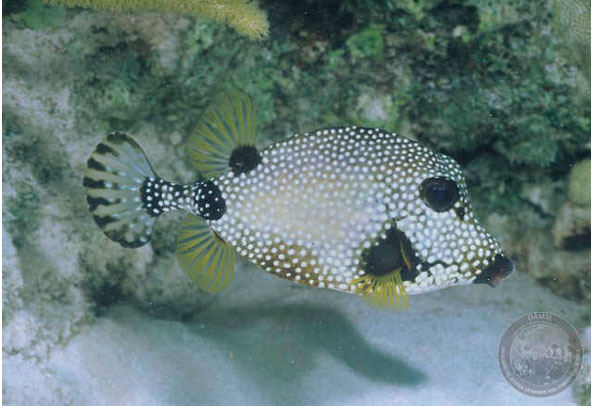Trunkfish Species
Trunkfish are saltwater fish belonging to the Ostraciidae family. The family contains boxfish, cofferfish, cowfish and trunkfish. Trunkfish are also called boxfish at times, making the names interchangeable. There exists at least 23 different species worldwide, divided over 6 genera. Trunkfish are most abundant in temperate and tropical seas and tend to stay in shallower waters. They don’t tolerate fish from the same family in their own territory. Trunkfish come in a variety of bright color patterns, but their body is always triangular and covered with hexagonal bony plates. This armored body and boxy design leads to limited mobility though. Their dorsal and anal fins propel the fish with rotary motion while the tail acts as a rudder with limited propulsion. This makes them very sluggish, inept swimmers. Their ventral fins also move continually to force air through their constricted gill openings.
Trunkfish are omnivores who consume minute plant and animal matter such as sponges, tunicates, sea cucumbers, sea urchins, algae and sea plants. Their jaws are powerful enough to crack open mollusks and crustaceans. They will bite off pieces of coral to get to the polyps or expose other prey underneath. Their lips protrude outward, and thus make it easier for spraying a jet of water to blow away bottom sediment. This helps to expose prey like worms. The two most prevalent species of trunkfish in the Atlantic and Caribbean basin are smooth and spotted trunkfish. Buffalo trunkfish also inhabit this region. Close cousins of these Atlantic trunkfish include the honeycomb and scrawled cowfish. While similar in design, cowfish can be identified by their “horns” or sharp spines over each eye. A trunkfish grows anywhere between 6-20 inches in length while a cowfish will generally grow up to 15 inches in length. Unlike trunkfish species in the Indo-Pacific basin, Atlantic-Caribbean trunkfish are more singular with flattened undersides that reinforce their angular structure.
When disturbed, trunkfish are capable of secreting a poison known as ostracitoxin that is fatal to other fishes. It’s even powerful enough to kill a nurse shark, but the toxin must be ingested to take effect. Their natural armor also makes it difficult for them to be preyed upon. Despite these defenses, they are still palatable for humans. Some South Pacific islands will serve trunkfish baked in their shells. They are an important food fish in many parts of the Caribbean. Currently, successful breeding of trunkfish in captivity has not been consistent. Luckily, trunkfish are of least concern according to the International Union for Conservation of Nature’s (IUCN) red list.

